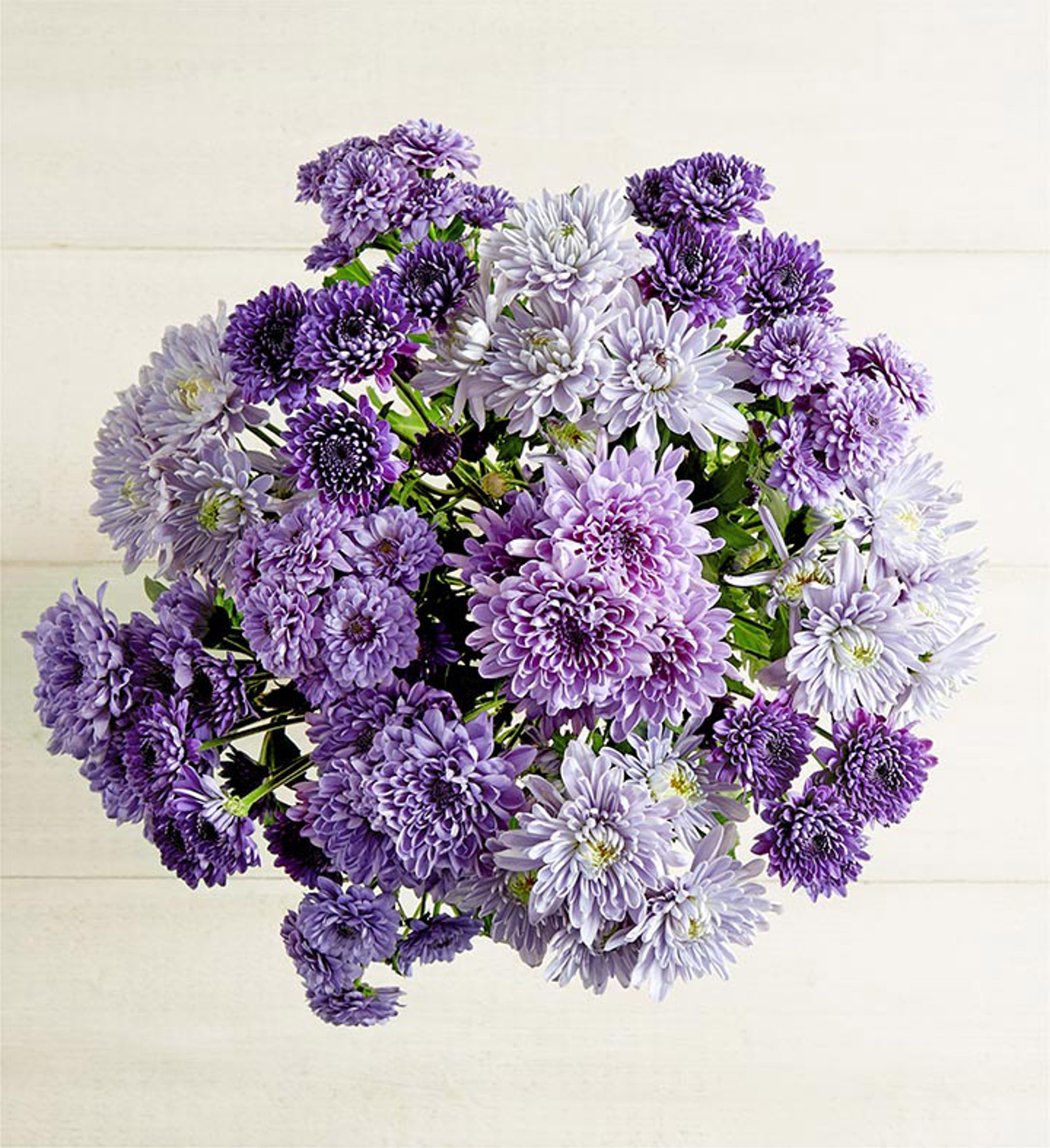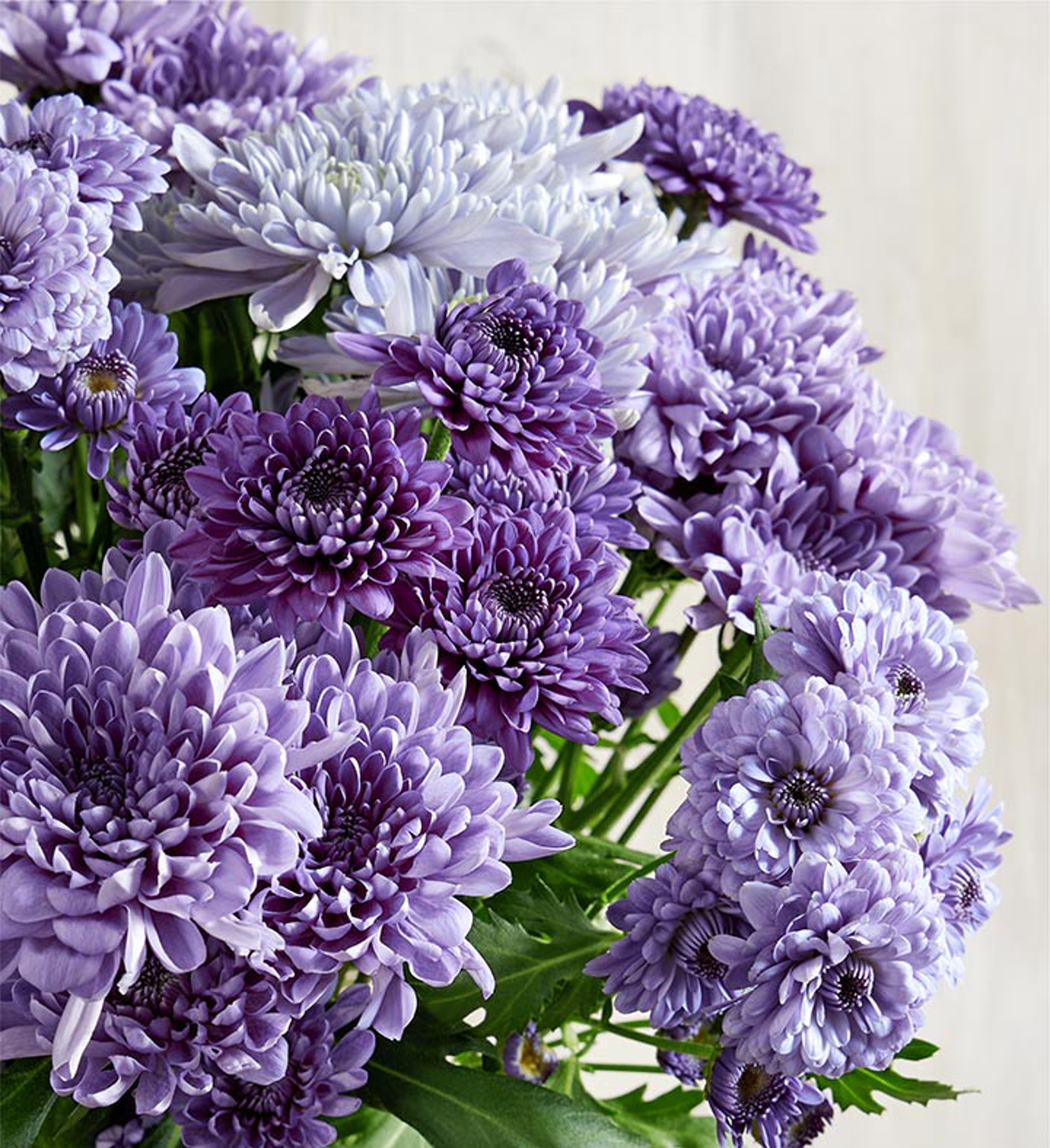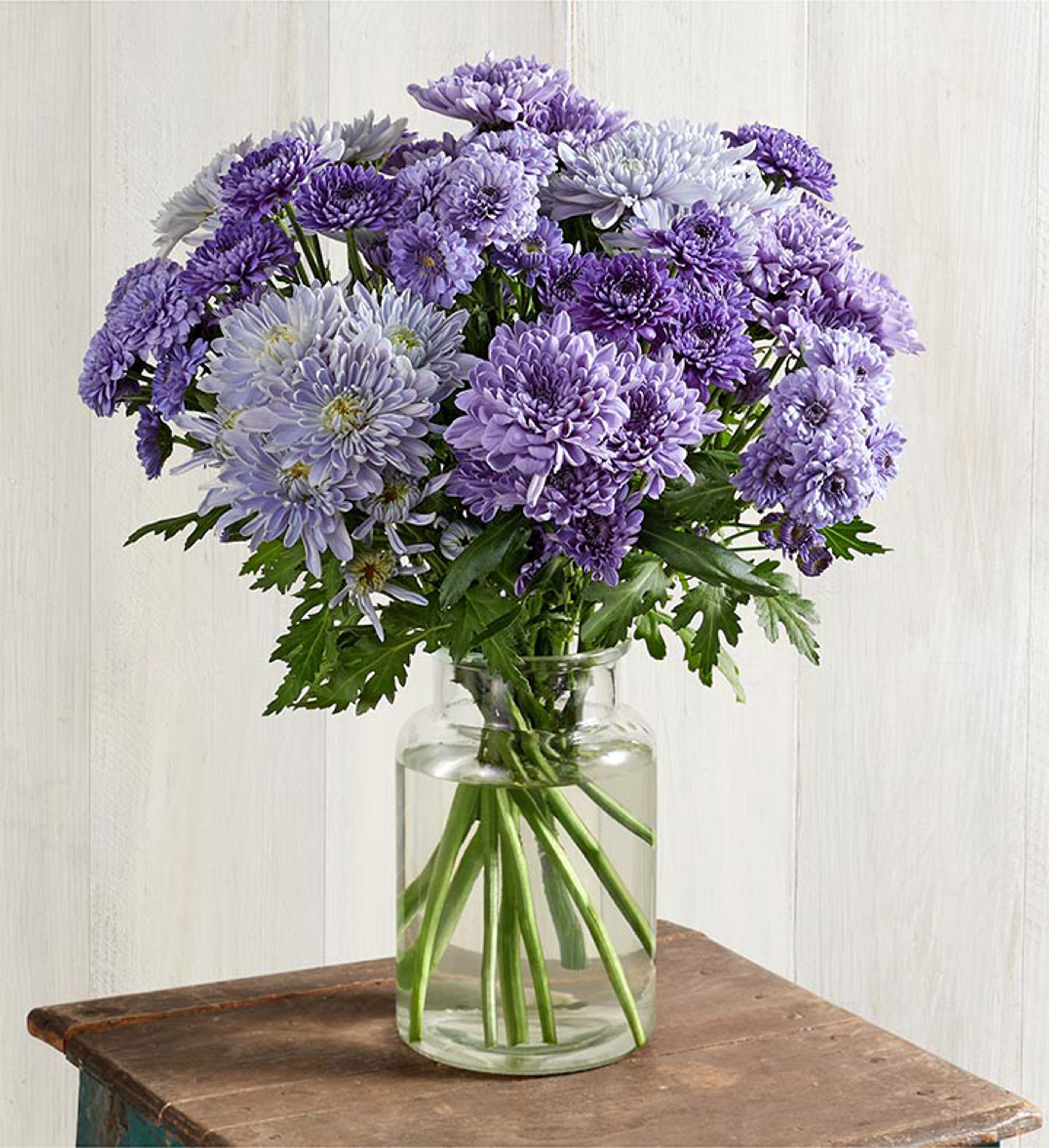The Story Behind the Creation of the Blue Chrysanthemum
It's a tale that begins in a Japanese lab and ends — if you're lucky — on your countertop.
Jul 02, 2024
With their wondrous, rounded, pom-pom or daisy-like appearance, chrysanthemums are a superstar of the plant world. In the garden, they’re hardy and low maintenance, a breeze to propagate, and a favorite of bees and butterflies alike.
As cut flowers, chrysanthemums, or simply mums, are also just as beloved. They’re easy to care for, long lasting, large and vibrant, and available in a wide variety of colors, from whites and yellows to orange, pink, and almost every shade of red.
But if you wanted to fill your planters — or your kitchen or dining room — with the beauty of “true blue” chrysanthemums, you were out of luck. This rare, elusive, and highly desired shade of flower just wasn’t available. Yet, thanks to some good luck and the wonders of science, all that has recently changed.

A rare and special shade
“Real” blue flowers are scarce in the plant world. Most of the blooms we see that we think are blue — from irises to clematis to salvia and periwinkles — are actually shades of purple or violet. It’s only a handful of commonly available flowers (including delphiniums, bluebells, cornflowers, and some hydrangeas) that are real and truly blue.
While it’s possible to artificially change the color of a flower through dying, dipping, or spraying its bloom (or even altering the pH level of the soil it grows in!), many botanists and researchers around the world have also taken this natural scarcity of blue flowers as a challenge. With just the right cross-breeding or hybridization, or some scientifically backed research, might another naturally occurring blue flower become a possibility? Thanks to some amazing discoveries made in Japan, we now know the answer to that question is yes.

Developing a “new” bloom
In Japan, chrysanthemums are a nationwide favorite. The flowers are believed to symbolize longevity and rejuvenation, and are an incredibly popular option to share with friends and loved ones. In that same vein, the Japanese also often associate the color blue — a color that reflects the natural elements of the sky and the sea — with tranquility and calmness. With these natural similarities between the meaning of the color and the flower, the idea of developing a blue chrysanthemum has been on the mind of scientists and botanists in the country for many years.
“The three most important cut flowers sold in the world are roses, chrysanthemums, and carnations. But none of them have blue flowers naturally,” says Naonobu Noda, a plant geneticist with Japan’s National Agriculture and Food Research Organization (NARO). “They just don’t have the genes to produce the pigment that creates the blue color. In general, not many flower species do. That’s why we wanted to create a blue flower color in these flowers — so consumers could enjoy them more!”
In 2013, Noda and his team joined in the quest to create the first-ever such flower.
“In general, new varieties of flowers are created by crossbreeding,” he explains. “However, it has not been possible to create a blue chrysanthemum because there are no wild relatives with blue flowers. But by using genetic modification technology, we were able to make the impossible possible. We introduced genes to make a plant pigment that could produce blue coloration, and we designed genes to work only on the petals. Through trial and error, we were able to develop a new variety of chrysanthemum with blue pigment in the petals.”
First, Noda and his colleagues tried adding a gene from another naturally blue flowering plant called the Canterbury bells to the chrysanthemum, but the resulting bloom was more of a violet. Next, they borrowed a gene from the naturally blue butterfly pea plant to see what happened — and to everyone’s surprise, it worked! While creating a new variety or color of plant can sometimes take decades, and much research never pans out at all, this team had achieved its goal on only its second attempt — and had done so in the matter of just a few years.
That Japanese discovery is an impressive and remarkable feat, according to Paul Debbie, director of research and new business development for the Boyce Thompson Institute, a research center located on the campus of Cornell University in Ithaca, New York. The institute is dedicated to using plant sciences to improve agriculture, protect the environment, and preserve biodiversity in the plant world.

While Debbie didn’t work on the development of the blue chrysanthemum, he did review the research for us. He expressed his surprise at how fast the new plant came about and how few trials were required before the blue bloom was created.
“This kind of research can be a very long process,” he says, “but in this case, everything came together pretty quickly.”
As for the science itself, it’s not as rare or complicated as you might think.
“The process of genetically engineering a plant like this has actually been around a long time,” Debbie explains. “It’s called plant transformation. Essentially, researchers take a strain of bacteria called Agrobacterium and add the gene they want to work with to it (in this case, the gene that causes the blue bloom). They then put that bacteria on a small piece of chrysanthemum leaf tissue, and the bacteria enters the leaf, bringing the new gene in with it.”
Once the gene enters the plant tissue, he says, that tissue is allowed to grow into a complete plant. And while developing a new type of flower — or even a new color of flower — in a lab might sound like something out of a science fiction novel, it’s actually, Debbie adds, a very common and widely used research process.
“At centers like ours,” he says, “we mainly use genetic engineering as a research tool. We’re doing it to increase crop size or plant yield and improve agricultural crops. But you can also do some pretty remarkable things working with other types of plants as well, as this research shows.”
Bringing the flower to market
The study detailing the Japanese development of the blue chrysanthemum was first published in a peer-reviewed scientific journal in 2017. Just a few years later, blue chrysanthemum plants were in full production, beginning to appear in select greenhouses and nurseries around the world.
Mallory Green, product development manager of direct floral at 1-800-Flowers.com, was entranced by BluOcean (the trademarked name for these wonders) chrysanthemums the first time she laid eyes on them.
“I saw them for the first time last fall,” she says, “and immediately was like, ‘We have to have that flower!’ The blue is just so beautiful, and it really stood out to everyone on our team. As floral experts, it’s rare to see something new, and especially in a new, unique color. When that happens, you can’t help but get excited.”
To bring the blue chrysanthemums into production, Green and her team began working with a group of farmers and growers in South America, where weather fluctuations are rare and a steady supply of blooms can be readily available for year-round harvest.

With that initial crop now completely grown, 1-800-Flowers.com is offering the remarkable flowers for the first time ever, either as just a bouquet or paired with a glass vase.
It’s the first of many new flower colors Noda sees coming in the years ahead.
“Along with blue chrysanthemums, genetically modified blue roses and blue carnations are already available worldwide,” he says. “Blue Phalaenopsis orchids are also available in Japan (and in the United States!). As research into flower color variation continues, I expect many more flower varieties will be developed in the future.”
Noda hints that black chrysanthemums are on his wishlist. But until that research is complete, he can’t wait to share his blue chrysanthemums with an even wider audience.
“They’re such a gorgeous flower,” Green adds. “We’re so excited to have them because they’re new, and so unique and compelling. That blue color is so special and rare in nature, and in the cut flower world, it really makes offering them to our customers extra fulfilling!”







